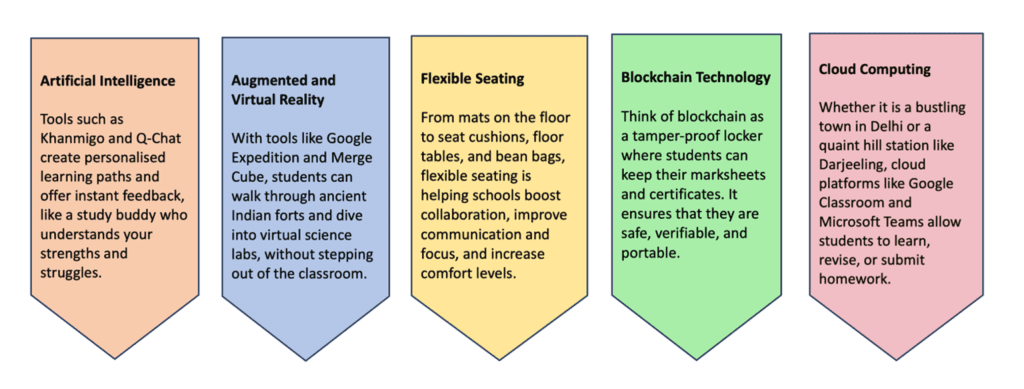![]()
Personalised, interactive, and transformative – welcome to the new world of education.
| In this blog article, you’ll find: • A new era in learning: Why smart classrooms lead the way • Real-world impact: Tech that is changing classrooms everywhere • Say hello to the famous five tech superheroes • Behind the screens: The gaps we can’t ignoreThe next class: 6 EdTech ideas that can redefine classroom learning |
S = Seamless
M = Measurable
A = Adaptive
R = Responsive
T = Tech-enabled
More than an acronym, this is the blueprint of a modern classroom. The evolution from smartboards to smart classrooms isn’t just about integrating new tools. It is a fundamental rethinking of how educators can teach purposefully and students learn passionately. It is also about creating smart classroom setups for modern schools that are inclusive and interactive.
A new era in learning: Why smart classrooms lead the way
We are witnessing a revolution in education through EdTech. Smart classrooms lie at the core of this evolution – vibrant learning environments that leverage interactive learning tools to deepen comprehension, personalise learning experiences, and engage students fully.
For example, in South Korea, AI-powered textbooks are used to continuously adjust lesson plans in real-time, helping students grasp concepts more effectively and stay motivated.

A meta-analysis of 21 studies in China mentioned in the 2024 Effects of Smart Classroom on Students’ Learning Outcomes article by ResearchGate revealed that smart classrooms significantly impact learning outcomes in place of traditional settings.
Real-world impact: Tech that is changing classrooms everywhere
From rural villages to world-renowned institutions, smartboards and digital tools are revolutionising education. Here are a few noteworthy examples of how innovation is introducing a new wave in classrooms globally.
- Sampark Smartshala: Empowering rural classrooms in India
Launched to improve learning outcomes for seven million children across 76,000 schools in India. Sampark Smartshala provides rural schools with low-cost audio devices, interactive learning tools, and a friendly teaching mascot – Sampark Didi.
- Solve Education!: Gamifying learning for better understanding
A Singapore-based non-profit organisation, Solve Education! developed Dawn of Civilization, which includes 30,000+ teaching materials that are used in daily English vocabulary, grammar, phrasal verbs, and much more.
- MIT’s TEAL Program: Giving physics an interactive touch
The Technology-Enhanced Active Learning (TEAL) program opts for interactive sessions that combine simulations, experiments, and problem-solving. The results? Failure rates dropped from 13% to under 5%, and learning gains more than doubled.
- One Laptop Per Child (OLPC): Bridging the digital divide
A non-profit initiative, OLPC Australia’s mission was to provide affordable, durable laptops to children in developing countries, which are designed for collaborative learning, with features suitable for remote and resource-limited settings.
Say hello to the…
FAMOUS FIVE TECH SUPERHEROES

Behind the screens: The gaps we can’t ignore
As we reimagine smart classrooms through various interactive learning tools, it is also important to identify and navigate the challenges. Because while innovation opens new doors, it must walk hand in hand with responsibility, inclusion, and foresight.
Digital dependency: Prolonged screen time among children is associated with cognitive and developmental challenges. According to the 2023 The Impact of Screen Time on Child and Adolescent Development article by the International Journal of Contemporary Pediatrics, extended exposure to digital devices can impair attention span, language acquisition, memory retention, and motor skill development.
Teacher training: Technology is only as effective as the teachers who utilise it. Yet, many educators feel either underprepared or unprepared for this digital shift. As per the Technology Integration in Teacher Education 2024 article, challenges such as inadequate experience and training in the use of technology hinder the effective integration of technology in teacher education programmes.
Data privacy: While classrooms go digital, cybersecurity breaches can be alarming. In 2024, PowerSchool, used by over 45 million students globally, suffered a cyberattack exposing sensitive student data. With 96% of edtech apps sharing data with third parties, protecting student privacy is more urgent than ever.
The next class: 6 EdTech ideas that can redefine classroom learning
Smart classrooms aren’t in the future anymore; they are already here. And they are smart, empathetic, data-rich, and global. Let’s look at how a revolution in education through EdTech is taking root in meaningful, human ways.
- Introducing co-learning across continents
With platforms such as Flip by Microsoft, students in different countries can collaborate on projects, from digital storytelling to climate awareness zones. This experience builds global perspective and digital collaboration skills.
| Why it matters: Students don’t just learn about the world. They learn with it. |
- Measuring growth, not just grades
Today’s learning analytics tracks much more than marks; they map mood shifts, collaboration habits, attention dips, and more. Tools like Classcraft even gamify growth areas like empathy and teamwork.
| Why it matters: Make the most of metrics to monitor, not just rank. |
- Seating that shapes the way you learn
Utilising RFID sensors and heat maps, schools can decode attention zones – areas where focus drops or conversations peak. Rotating seating based on student learning styles and group dynamics increases interactions and reduces participation gaps.
| Why it matters: Strategic placement improves focus as well as boosts collaboration and reduces social barriers. |
- Personalising learning with adaptive AI
AI-driven platforms have adjusted in real time to every student’s pace, performance, and preferred learning. From quizzes that evolve to video lessons that pause and prompt, adaptive tools ensure that no learner is left behind.
| Why it matters: When learning feels personal, every student feels seen and no one falls behind. |
- Giving shy students a way to express themselves
AI tools can collect and keep a student’s response anonymous, giving hesitant voices or introverts the space to shine without the fear of judgment and creating a safe space for them to express themselves freely.
| Why it matters: Not every student raises a hand, but every voice deserves to be heard. |
- Making privacy a priority, not an afterthought
With incidents like the PowerSchool data breach affecting millions, schools must proactively audit apps, verify privacy policies, and onboard tools that comply with child data regulations.
| Why it matters: Making digital hygiene and privacy an essential and core part of a trusted learning environment. |
Smart classrooms are no longer just about devices and digital boards. It is a bold shift toward a more compassionate, connected, and inclusive way of learning. As we weave educational technologies like AI, immersive tools, and global collaboration into education, the true measure of progress isn’t in the technology itself, but in how deeply it serves equity, empathy, and purpose. The future of education isn’t just intelligent; it is intentional. It uplifts educators, honours every student’s voice, and turns classrooms into spaces of possibility, without the pressure.
VIBGYOR World Academy is VIBGYOR Group of Schools’ technology-enabled school at Nagpur and Bhopal.
